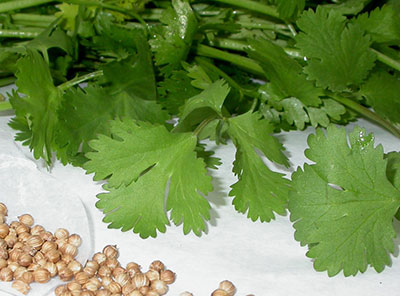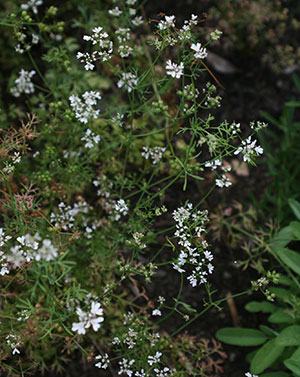Cilantro

Cilantro leaves and seeds. Photo courtesy of Iowa State University Extension.
Cilantro (Coriandrum sativum) is a bright green annual plant with many culinary applications. This flat, feathery-leafed herb is often used in Latin American and Southeast Asian cooking. It can add a fresh flavor to many dishes, including salsa.
And here's a fun fact: the spice coriander is made from the seeds of the Coriandrum sativum plant. The same plant that provides you with cilantro in cooler seasons will produce seeds in warmer weather. Ground coriander seeds are the main ingredient in the Indian "garam masala" spice mix. The roots are even used in Thai curries.
Characteristics
Cilantro is a small plant reaching about one foot in height. Before it produces seeds, cilantro plants will have umbels of pinkish-white flowers which are very attractive to pollinating insects.
Cilantro's flavor is similar to parsley, though it's a bit more tangy. While many people enjoy the flavor, some people describe it as tasting like soap (recent studies suggest substances in the plant called aldehydes are to blame). The spice coriander has a variety of cooking uses; from deserts and candies to meats and relishes, this tiny seed can be added to many dishes. Coriander can be used whole or crushed in cooking.
Planting and Care
If you want to grow Coriandrum sativum in your garden, you can start it from seed or purchase transplants. Plants should be spaced eight inches apart to allow them room to grow and thrive.
Sow a few seeds at a time every few weeks to give you a steady supply of cilantro. This herb will do best in an area with full sun to part shade and rich, well-drained soil.
In Florida, it's best to grow cilantro in fall and winter since it tends to quickly flower and go to seed when the days get long and warm. Cilantro leaves can be harvested early, once the plants reach 6 inches tall, and continuously thereafter until the plant dies.
If it's coriander you're after, be on the lookout for seeds about three months after planting. To harvest, remove the brown, fruiting structures from the plant and allow them to dry. Once they have dried, remove the seeds from the fruiting structures (this process of removing seeds from the plant and breaking up remaining plant materials is officially called threshing). Store the seeds in a dry, tight container.

Cilantro, flowering
For more information on growing cilantro in your area, contact your county Extension office.

